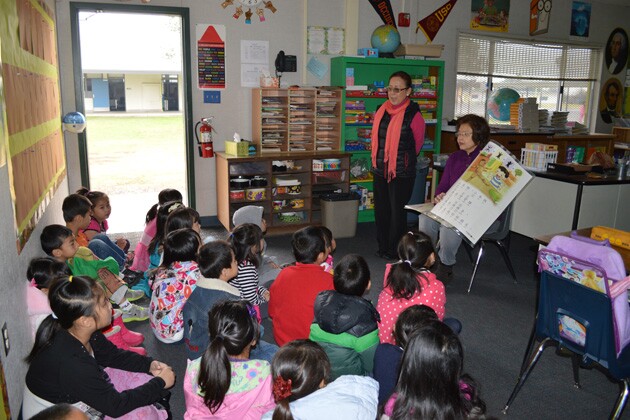Bridging Cultures at El Monte Education Center

Red envelopes are nothing new to Samantha Ubillus. The 13-year-old with sinewy limbs, a charismatic smile, and long brown hair has been learning about Chinese New Year traditions since she was a little kid. An eighth grader now, Ubillus began studying Chinese five years ago when her parents first encouraged her to take Chinese lessons.
"If I can learn Chinese, a lot of other people can," said Ubillus, who grew up in El Monte.
Ubillus is just one of approximately 150 students who attends Chinese classes at El Monte Education Center (EMEC), a nonprofit that offers extracurricular learning to local students and cultural awareness through educational activities. Established in 1993, the center offers supplemental English and math tutoring during the weekdays along with language classes on the weekends. Many of the students who attend the Chinese courses, held on Saturday at Rio Vista Elementary School, are are second-generation immigrants whose parents emigrated from countries such as China and Malaysia.
"We welcome kids from all over to come to our school," said Chang Chih Yeh, the principal of EMEC. "The more languages you know, the more ability you have to make a living. Everybody knows English but not everybody knows Chinese. For the children's future, their outlook is more positive."
While others are still sleeping in on the weekend, the students are already hard at work. They arrive bright and early to gather in the courtyard for morning instructions. In the classroom, they go over lessons in the textbook, strengthening their Chinese reading and writing skills. Some of the younger children are even taught songs and dances to help them become engaged with the language.

Ubillus first sat in at age five at the kindergarten level, learning the fundamentals such as tones and pinyin, a phonetic system for transcribing Mandarin pronunciations into the English alphabet. She even learned to write her name in Chinese. Slowly but surely, she was able to gain more knowledge on the language and could say short phrases, including "Hello," "Good morning," "Happy birthday," and "My name is Samantha" in Mandarin. She admits the classes were difficult at first.
"I'm able to pick up some words when other people talking and, even though I don't know all the words they're saying, I can pick up some and think about what they're saying," said Ubillus, who hopes to visit China one day.
According to the U.S. Census Bureau, the use of a language other than English at home increased by 23.4 million speakers (211 percent) between 1980 and 2007. In 2007, of 281 million people who were ages five or older, 55.4 million people (20 percent) spoke a language other than English at home. Of the people surveyed, 62 percent spoke Spanish and 15 percent spoke an Asian or Pacific Island language. After English and Spanish (34.5 million speakers), Chinese (2.5 million speakers) was the language most commonly spoken at home.
And according to an article from DANA Foundation, a private philanthropic organization focused on brain research, bilingual brains "can have better attention and task-switching capacities than the monolingual brain." In addition, bilingual children can better adjust to environmental changes. The authors noted that, along with cognitive benefits, bilingualism brings about social benefits such as exploring a culture through its native tongue, or chatting with someone with whom you normally wouldn't be able to communicate.

At EMEC, Ubillus believes meeting new friends has helped her to open up and not be as shy. Along the way, she started taking dance classes and worked with instructors from the Shining Star Dance Academy, which is under the umbrella of EMEC and offers classes such as Chinese folk dance. This fall, she'll be attending high school and plans on continuing with her Chinese education by enrolling in the Mandarin language track. She is working towards becoming trilingual, having already been fluent in Spanish and English.
Ubillus's parents are proud of her multilingual accomplishments and support her as much as possible. In the last few years, when her father couldn't drop her off at class, she and her mother would take a taxi or a bus to make sure she arrived to class on time. Her father, Wilfrido Ubillus, stresses the importance of having children learn foreign languages at a young age, and cited the economic benefits as one of the reasons his daughter chose to learn Mandarin. "I like her to take Mandarin because I know it's going to be great potential for her," said Wilifrido, whose family is originally from Ecuador.
According to the U.S. Department of Labor's Bureau of Labor Statistics, jobs such as interpreters and translators are on the rise. From 2012 to 2022, the organization anticipates that the job outlook for these positions will increase by 46 percent, faster than the average change of employment for other jobs.
Patricia Gándara, research professor of education at UCLA, has also highlighted the advantages of bilingualism in her book "The Bilingual Advantage: Language, Literacy and the U.S. Labor Market." Studies cited in the book notes how multilingual fluency can be a benefit in the job market, and that "bilinguals were more likely to be hired than those who only spoke only one language." Gándara also states that an acceptance of bilingualism and/or multilingualism in the U.S. could help bring about equity and economic social mobility for those who speak other languages.
Wilfrido Ubillus fully understands how learning a foreign language can benefit her daughter. "She's going to have a lot of opportunities to travel to China," he said. "And, for me to see her in the future, I'm not worried about it because I know she's going to be doing great."
